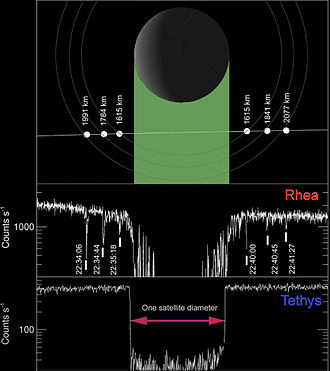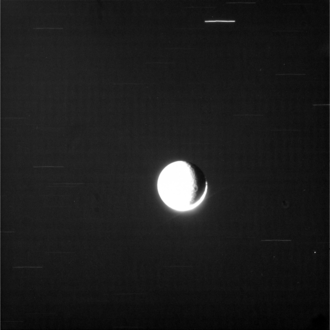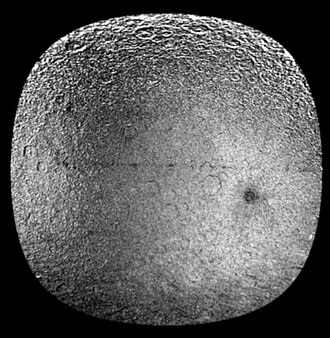Rings of Rhea





Rings of Rhea are a system of rings around Saturn's second-largest moon, Rhea. Discovered in speculative observations, the existence of these rings remains a subject of debate within the scientific community. If confirmed, Rhea would be the first moon known to have its own ring system, marking a significant discovery in the field of planetary science and astronomy.
Discovery[edit]
The potential discovery of Rhea's rings was first announced based on observations made by the Cassini spacecraft, which has been instrumental in advancing our understanding of the Saturnian system. The spacecraft's instruments aimed to detect the rings by analyzing the distribution of electrons around Rhea, suggesting the moon might be surrounded by bands of material.
Composition and Structure[edit]
The hypothesized rings of Rhea are thought to be composed of small, solid particles, similar to the rings found around planets like Saturn. These particles could range from microscopic dust to larger chunks of ice or rock, potentially remnants from micrometeoroid impacts on Rhea's surface or the result of a past collision with another celestial body.
Scientific Significance[edit]
The existence of rings around a moon like Rhea would have profound implications for our understanding of ring dynamics and the history of the Saturnian system. It would challenge existing models of ring formation and stability, particularly in the context of a moon's gravitational field. Additionally, studying Rhea's rings could provide insights into the processes that lead to ring formation around planets and the potential for similar phenomena around other moons in the Solar System.
Controversy and Challenges[edit]
The initial findings suggesting the presence of Rhea's rings have been met with skepticism. Subsequent observations and analyses have failed to conclusively detect the rings, leading to ongoing debate about their existence. The challenges in confirming the rings of Rhea stem from their potential faintness and the difficulty in distinguishing ring material from the moon's surface or surrounding space environment.
Future Exploration[edit]
Future missions to the Saturnian system may provide the opportunity to resolve the question of Rhea's rings. Advanced instruments and closer observations could offer definitive evidence of the rings or, alternatively, explain the initial observations that suggested their presence. The continued exploration of Saturn and its moons remains a priority for planetary scientists, with Rhea's potential rings being a topic of particular interest.
Ad. Transform your life with W8MD's Budget GLP-1 injections from $75


W8MD offers a medical weight loss program to lose weight in Philadelphia. Our physician-supervised medical weight loss provides:
- Weight loss injections in NYC (generic and brand names):
- Zepbound / Mounjaro, Wegovy / Ozempic, Saxenda
- Most insurances accepted or discounted self-pay rates. We will obtain insurance prior authorizations if needed.
- Generic GLP1 weight loss injections from $75 for the starting dose.
- Also offer prescription weight loss medications including Phentermine, Qsymia, Diethylpropion, Contrave etc.
NYC weight loss doctor appointmentsNYC weight loss doctor appointments
Start your NYC weight loss journey today at our NYC medical weight loss and Philadelphia medical weight loss clinics.
- Call 718-946-5500 to lose weight in NYC or for medical weight loss in Philadelphia 215-676-2334.
- Tags:NYC medical weight loss, Philadelphia lose weight Zepbound NYC, Budget GLP1 weight loss injections, Wegovy Philadelphia, Wegovy NYC, Philadelphia medical weight loss, Brookly weight loss and Wegovy NYC
|
WikiMD's Wellness Encyclopedia |
| Let Food Be Thy Medicine Medicine Thy Food - Hippocrates |
Medical Disclaimer: WikiMD is not a substitute for professional medical advice. The information on WikiMD is provided as an information resource only, may be incorrect, outdated or misleading, and is not to be used or relied on for any diagnostic or treatment purposes. Please consult your health care provider before making any healthcare decisions or for guidance about a specific medical condition. WikiMD expressly disclaims responsibility, and shall have no liability, for any damages, loss, injury, or liability whatsoever suffered as a result of your reliance on the information contained in this site. By visiting this site you agree to the foregoing terms and conditions, which may from time to time be changed or supplemented by WikiMD. If you do not agree to the foregoing terms and conditions, you should not enter or use this site. See full disclaimer.
Credits:Most images are courtesy of Wikimedia commons, and templates, categories Wikipedia, licensed under CC BY SA or similar.
Translate this page: - East Asian
中文,
日本,
한국어,
South Asian
हिन्दी,
தமிழ்,
తెలుగు,
Urdu,
ಕನ್ನಡ,
Southeast Asian
Indonesian,
Vietnamese,
Thai,
မြန်မာဘာသာ,
বাংলা
European
español,
Deutsch,
français,
Greek,
português do Brasil,
polski,
română,
русский,
Nederlands,
norsk,
svenska,
suomi,
Italian
Middle Eastern & African
عربى,
Turkish,
Persian,
Hebrew,
Afrikaans,
isiZulu,
Kiswahili,
Other
Bulgarian,
Hungarian,
Czech,
Swedish,
മലയാളം,
मराठी,
ਪੰਜਾਬੀ,
ગુજરાતી,
Portuguese,
Ukrainian
